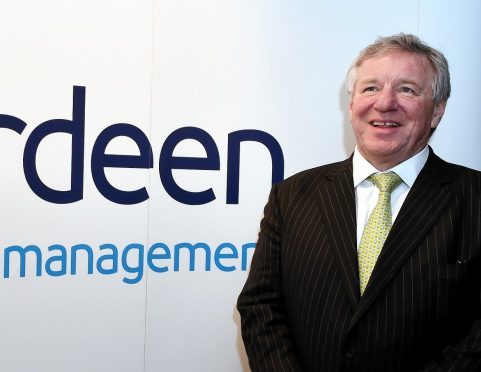The stock market flotation of Aberdeen Asset Management “only seems like yesterday” – although the firm has just celebrated 25 years of being a listed company.
The move was made to lend the firm, which was founded in 1983, “greater credibility in the eyes of the City”.
Back then, its market capitalisation was £38million compared to £3.6billion when markets closed last week. Likewise, assets under management have grown from £1billion to £290billion making it the third largest listed fund manager in Europe.
It’s chief executive Martin Gilbert one of the best known Scots in London’s square mile, with a long sheet of former and current board appointments, including being deputy chairman of satellite TV giant, Sky, as well as formerly chairing FirstGroup. Regular appearances at the annual meeting of the world’s most influential financiers at Davos have also featured.
But the firm is facing challenges in its 25th year of listed trading as it suffers a long bout of heavy investor outflows due to its exposure to volatile Asian markets. The group has seen its share price fall 43% in the last year. The firm also fell out of the FTSE’s top 100 companies this month due to the slump.
Recently Mr Gilbert, who is currently 60, revealed he wanted to stay leading the company he co-founded for another five years. It further quelled persistent speculation that the recently weakened firm was an acquisition target.
He took the rumours head on, saying that “every investment banker in the world would probably have us on their list as the number one buying opportunity”, adding: “What we’ve always said is being independent is a massive advantage to us and as long as our shareholders are willing to support us we’d rather stay independent.”
In May, Mr Gilbert, the board and senior managers have been invited to the London Stock Exchange where there will be a small ceremony ahead of them pressing the button to open the market at 8am.
Yesterday Mr Gilbert said: “It only seems like yesterday. The company’s growth since we listed is unbelievable and primarily down to the people.
“Asset management is a peoples’ business and I’ve been fortunate to work with some exceptional people, including Ronnie Scott Brown, George Robb, Andrew Laing, Bill Rattray, Ken Fry and Hugh Young to name but a few.
“The company has had its fair share of ups and downs but our commitment and focus on the long term has helped to create one of the largest independent asset managers in the world from very small beginnings.
“The global diversified business that has been created and the quality of people we employ mean Aberdeen is well placed to continue to help our clients achieve their investment goals and to grow over the next decades.”
Timeline
- 1983: Founded as Aberdeen Fund Managers by Martin Gilbert, Ronnie Scott Brown and George Robb, the company was formed to take over the investment business of a local Aberdeen firm of solicitors, providing fund management and secretarial services to Aberdeen Trust PLC, a quoted investment trust and to a small number of institutions and private clients. Total assets under management, £70million
- 1988: Hugh Young joins Aberdeen
- 1991: Listed on the London Stock Exchange under the name Aberdeen Trust. (Name changed to Aberdeen Asset Management in 1997.)
Throughout the 1990s the firm grew rapidly, taking on assets in Asia and Europe and setting up offices in Singapore and Hong Kong. - 1997: Acquired Prolific Financial Management from Scottish Provident, which made it a UK top-10 unit trust manager.
- In 2000, purchased Murray Johnstone (UK), an international equities and bonds managers, and Equitilink, an Australian manager of domestic assets and US closed-end funds.
- 2002: Aberdeen hits its lowest point having to pay £75million in redress in the wake of the so-called “split cap crisis”.
- 2003: A major sale of UK retail unit trusts to New Star brings the company £87.5million. This, among other acquisitions, helps fund the firm’s fight back and acquisition of Edinburgh Fund Managers.
- 2005: Acquire the UK and US institutional businesses of Deutsche Asset Management.
- 2009: Complete acquisition of asset management company Credit Suisse, which we had begun in 2008.
- 2010: Acquire assets and contracts from RBS Asset Management in an £84.7million deal.
- 2012: Aberdeen joins the FTSE 100 for the first time.
- 2014: Aberdeen announces the completion of the £650million acquisition of Scottish Widows Investment Partnership.
- 2015: Acquired SVG Capital’s stake in joint venture vehicle, Aberdeen SVG Private Equity Managers, also Flag Capital Management to establish a strong alternatives footprint in the US; and Advance Emerging Capital (AEC).
- 2016: Acquisition of Arden Asset Management a provider of hedge fund solutions with offices in New York and London and fintech company, Parmenion.
